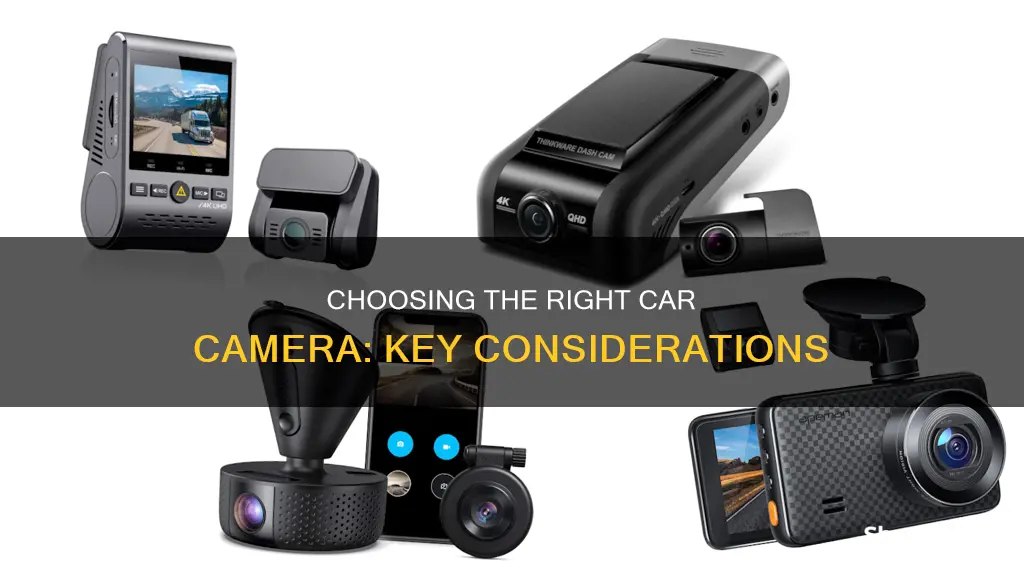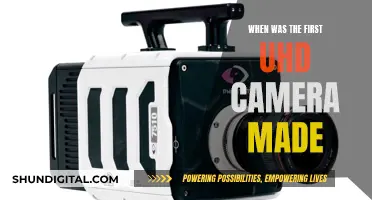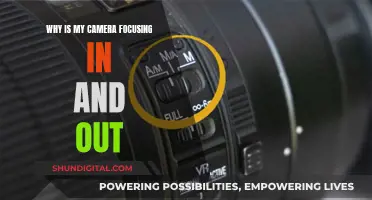
There are many reasons to install a camera in your car, from monitoring your driving habits to keeping an eye on your vehicle while it's parked. When selecting a car camera, it's important to consider your specific needs and concerns. For example, if you're primarily interested in recording while your car is in motion, you should look for a dash cam with features like a wide field of view, a high frame rate, and emergency recording. On the other hand, if you're more concerned about monitoring your vehicle while it's parked, a simple battery-powered camera might be a better option. Other factors to consider include mounting options, screen availability, storage capacity, and additional features like Wi-Fi connectivity and GPS tracking. By carefully evaluating your requirements and the features offered by different car cameras, you can make an informed decision about which device is right for you.
| Characteristics | Values |
|---|---|
| Purpose | Safety, security, monitoring, evidence for insurance claims |
| Camera Placement | Front, rear, dual |
| Camera Resolution | 1080p, 1440p, 2K, 4K |
| Field of View | 140°, 162°, 180° |
| Frame Rate | 30fps, 60fps |
| Operating Temperature | Check specifications, especially if in a hot or cold region |
| Mount Type | Suction, adhesive |
| Screen | Built-in, removable |
| Storage | SD card, cloud |
| Wi-Fi | Yes, no |
| GPS | Yes, no |
| Voice Control | Yes, no |
| Night Mode | Yes, no |
What You'll Learn
- Budget: Simple and affordable options exist, while advanced features demand premium prices
- Field of View: A wider field of view captures more detail, like number plates
- Durability: Check minimum and maximum operating temperatures, especially in extreme climates
- Mounting: Think about where you'll place the camera, and whether you want a permanent adhesive
- Features: GPS, Wi-Fi, and dual-camera modes are available on some models

Budget: Simple and affordable options exist, while advanced features demand premium prices
When it comes to choosing a car camera, there are a variety of options available, from simple and affordable models to advanced cameras with premium price tags. Here are some factors to consider when making your decision:
Budget
Simple and affordable car cameras are available for those who don't want to break the bank. These basic models typically offer standard features such as video recording, motion detection, and loop recording. They may have lower resolutions, such as 1080p or 720p, and may lack advanced features like night vision or GPS tracking. However, they can still provide peace of mind and capture important footage in the event of an accident.
On the other hand, advanced car cameras with premium features will demand a higher price. These models offer higher resolutions, such as 4K or Ultra HD, resulting in sharper and more detailed footage. They often include additional features such as GPS tracking, Wi-Fi connectivity, and advanced driver assistance systems. For example, the Nextbase iQ Smart Dash Cam offers a full suite of security and driver assistance features, including parking assistance, a voice-activated Witness Mode, and the ability to check on your vehicle remotely. While these advanced cameras come with a higher price tag, they provide a more comprehensive and feature-rich experience.
When deciding on a budget for your car camera, consider your specific needs and how often you plan to use the device. If you're an occasional driver or simply want basic protection, a simple and affordable option may be sufficient. However, if you're a frequent driver or want the added benefits of advanced features, investing in a premium car camera may be worth the cost.
It's important to remember that the cost of a car camera doesn't always indicate its quality. Some affordable options may offer excellent performance and durability, while some premium models may have features you don't necessarily need. It's essential to research and compare different models to find the best fit for your requirements and budget.
The Magic Behind Camera Glass Manufacturing
You may want to see also

Field of View: A wider field of view captures more detail, like number plates
When selecting a car camera, it is important to consider the field of view (FOV) that the camera offers. The FOV is the angular extent of the observable world that the camera can capture at any given moment. In other words, it is the width of the area that the camera can see.
A wider field of view is advantageous as it allows the camera to capture more detail. For example, a car camera with a wider FOV will be able to capture number plates, which can be useful in the event of an accident or when monitoring traffic. A wider FOV can also improve safety by providing the driver with a greater awareness of their surroundings, reducing the risk of collisions.
The FOV of a camera is influenced by the lens focal length and image sensor size. In general, a wider FOV will result in a lower image resolution. When selecting a car camera, it is important to consider the trade-off between the field of view and image resolution, as well as the specific needs of the driver.
Some car cameras offer a surround-view or bird's-eye view feature, which uses multiple cameras positioned around the vehicle to provide a top-down view. These systems can provide a wider FOV and improve the driver's situational awareness, making tasks such as parking easier and safer.
When installing a car camera, it is important to consider the mounting position to ensure the desired field of view is achieved. For example, a rear-view camera should be mounted on or behind the license plate to provide a clear view of the area behind the vehicle.
Understanding Camera Raw: A Stand-Alone Powerhouse?
You may want to see also

Durability: Check minimum and maximum operating temperatures, especially in extreme climates
When selecting a car camera, durability is a key consideration. One crucial factor to examine is the camera's operating temperature range, especially if you reside in a region with extreme weather conditions.
Most car cameras are designed to function effectively within a temperature range of 0° Celsius to 40° Celsius (32° Fahrenheit to 104° Fahrenheit). This range is suitable for moderate climates and ensures that the camera can withstand cold winters and moderately hot summers. However, if you live in an area with extremely cold winters or scorching summers, you should opt for a camera with a wider temperature range.
For instance, if you reside in a region with frigid winters, consider selecting a camera that can operate at temperatures as low as below -10° Celsius (14° Fahrenheit). This will ensure that your camera continues to function properly even during the coldest months. On the other hand, if you live in an area with sweltering summers, look for a camera that can withstand temperatures above 40° Celsius (104° Fahrenheit). This will prevent the camera from overheating and potentially malfunctioning.
It is worth noting that extreme temperatures can affect not only the camera's performance but also its internal components. For example, batteries may lose their ability to hold a charge in freezing temperatures, and high temperatures can cause certain parts to expand or contract beyond their designed tolerances. Additionally, direct sunlight can cause the camera's internal temperature to rise significantly, potentially leading to overheating.
To mitigate these issues, consider storing your camera in a controlled environment, such as the glove compartment or centre console, when it is not in use. This will help regulate the temperature and protect the camera from extreme conditions. Furthermore, ensure that your camera has adequate ventilation to prevent overheating.
By selecting a car camera with an appropriate temperature range and taking the necessary precautions, you can ensure the durability and longevity of your device, even in extreme climates.
Surveillance on the Streets: Police Cars and Cameras
You may want to see also

Mounting: Think about where you'll place the camera, and whether you want a permanent adhesive
When selecting a car camera, it's important to consider the mounting options and whether you prefer a permanent adhesive solution or a more flexible setup. Here are some factors to think about:
Suction Cup Mounts
Suction cup mounts are a popular choice for car cameras as they offer a secure and removable option. They can be attached to smooth and non-porous surfaces, such as the windshield or dashboard. Suction cups are easy to set up and provide a strong hold, but it's important to ensure the surface is clean before mounting. One disadvantage of suction cups is that they may not work as well on textured or porous surfaces, and age or dirt can affect their adhesion.
Magnetic Mounts
Magnetic mounting is another viable option, especially if your car has metal surfaces. Magnetic mounts are strong and can be easier to remove than suction cups. They typically have a rubberized exterior to protect the mounting surface. One clever trick with magnetic mounts is to use two magnets, one on the inside and one on the outside of the car, which can be useful for mounting inside the windshield without obstructing the driver's view.
Permanent Adhesive
Some car cameras or mounts come with a permanent adhesive, which provides a secure and long-lasting attachment. This option may be preferable if you want a more permanent solution and don't plan to remove the camera frequently. However, it's important to consider that removing the camera or mount may be difficult and could potentially damage the surface.
Other Mounting Options
There are also other mounting options available, such as hood mounts, side mounting, or using a car headrest as a mounting point. When choosing a mounting location, it's crucial to ensure that the camera doesn't obstruct the driver's view and that all safety precautions are followed. Additionally, some cameras offer multiple mounting options, giving you the flexibility to choose the best location for your needs.
In summary, when selecting a car camera, consider the mounting options that best suit your needs. Suction cups and magnetic mounts offer flexibility and ease of installation, while permanent adhesive provides a more long-term solution. Always follow safety guidelines and ensure that your camera setup does not obstruct your view or distract you while driving.
The Evolution of Computers: Integrated Cameras
You may want to see also

Features: GPS, Wi-Fi, and dual-camera modes are available on some models
GPS, Wi-Fi, and dual-camera modes are available on some car camera models, and they can be extremely useful. GPS functionality, for instance, can record your driving location and speed, enhancing the reliability of captured footage. This feature is especially useful for ride-share drivers, as it can provide a clear record of the vehicle's route and location. Wi-Fi connectivity, on the other hand, allows for seamless transfer of recordings to your smartphone or other devices. This makes it easy to share footage with insurance companies, law enforcement, or other relevant parties in the event of an accident or incident.
Dual-camera modes, which typically include a front-facing and rear-facing camera, offer a comprehensive view of your surroundings. This can be particularly useful for capturing incidents that occur in front of or behind your vehicle, providing valuable evidence in the event of a collision or dispute. Additionally, some car cameras with dual-camera modes may have interior-facing cameras, which can be beneficial for ride-share drivers or fleet managers who want full coverage of the vehicle's interior.
When selecting a car camera with GPS, Wi-Fi, and dual-camera modes, it is important to consider your specific needs and budget. These advanced features often come with a higher price tag, so it is worth weighing the benefits against the cost. Additionally, factors such as video quality, ease of use, and compatibility with your vehicle should be taken into account to ensure you choose the right car camera for your requirements.
Live Mode: iOS Camera's Hidden Feature
You may want to see also
Frequently asked questions
This depends on your intended use. If you want to record while your car is in motion, a dashcam is a good option. If you want to record while your car is parked, a simple battery-powered camera is a better choice.
Important features to consider include field of view, frame rate, temperature durability, mounting options, built-in screens, Wi-Fi capability, and GPS tracking.
The installation process will vary depending on the type and model of the camera. Some cameras can be easily installed by the user, while others may require professional installation. You can refer to online guides or manuals for specific installation instructions.







